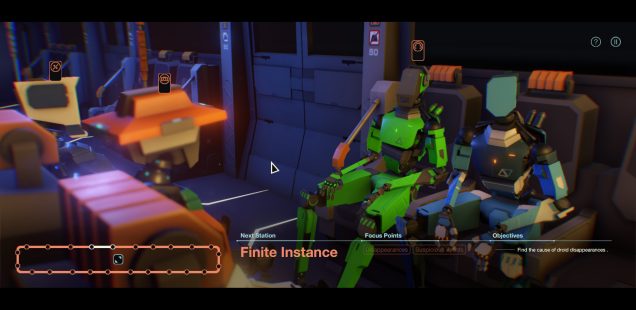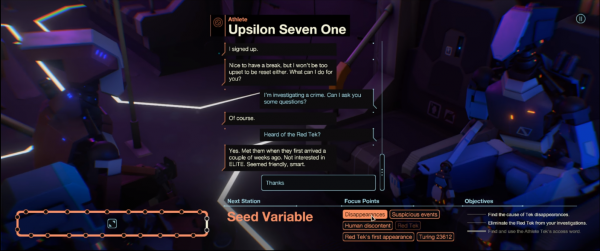
Mixed Media: Tunnel Vision
April Tyack launches an investigation into the Subsurface Circular.
Indie games are unduly burdened with Triple-A expectations: in 2017, it’s still a commercial liability to release a videogame that takes less than 10 hours to complete. Lacking the budget or cultural capital to address these misplaced expectations, indie developers turn to design: the most commercially successful games in this space tend to suggest they could be played forever, supporting ‘emergent’ play in a sandbox environment (e.g., Terraria), procedurally generating infinite content (e.g., The Binding of Isaac), and so on. August saw an exception in the largely unadvertised release of Subsurface Circular, a self-labelled “Bithell short”: a linear, two hour experience, refined over four months of development. Its integration of character design, interface, and narrative, aimed towards a relatively narrow experience, is somewhat of a rarity in the present context. Regardless, Subsurface Circular presents an approach to design that disregards conventions around linearity and replay value.
You play as a robot (“tek”) detective conducting an investigation from a carriage in the titular “subsurface circular” — in other words, a train on a circuitous underground track. The game is set in a future society with what appears to be a fully automated economy: teks fill most positions previously held by humans (amusingly, teks also comprise the entirety of the game’s cast). However, the highest levels of societal and economic organisation (“The Management”) are run by humans alone. Subsurface Circular problematizes this social order within a detective story concerning a case of disappearing teks.
Teks are allowed functionality only to the extent their current role requires it. Detectives apparently possess high intelligence, and although the nature of this is left ambiguous, it seems closer to traditional ideas on AI than machine learning. However, it comes with a cost — humans distrust intelligent teks, and you are unable to leave the train (or, apparently, your seat) as a result. This recasting of development constraints as quirks of worldbuilding recurs throughout; indeed, scope limitations are crucial to the way Subsurface Circular structures experience.

This experience hangs on answering a seemingly innocuous question introduced during the first conversation: why are teks disappearing? Subsurface Circular centres this investigation through its expression in a single mode of action — dialogue — and by displaying only contextually relevant details in the interface. The game’s reliance on conversation may at first seem like a poor choice. Videogames tend to offer only a small number of discrete conversational options; this is generally the basis of unfavorable comparisons to other forms of player action (which are nonetheless limited by discrete frame counts). Subsurface Circular uses this apparent weakness as another way to focus players towards performing their justified in-world role. Indeed, many videogames allow (implicitly investigational) dialogue with other characters for the sole purpose of informing the player — conversation begins with the same button press assigned to ‘use’ inanimate objects, without much interest in articulating why someone should pause, anywhere and at any time, to be quizzed about local trivia. Conversations in Subsurface Circular begin with a greeting.
The case is resolved over seven sequences, each framed by the introduction of a new investigatory question. Your progress towards following up on each of these leads, and answering the initial question, is always visible on-screen, and ‘focus points’ identified by other teks guide discussion towards topics with immediate and long-term relevance to the case. Even the train’s movement links to player objectives: narrative beats are punctuated by announcements signalling the next stop, and teks leave the carriage when their role in a sequence is fulfilled. Sequences drive Subsurface Circular forward and help unify its design.
Character designs also reflect this transience: teks are given histories, or memories, only to the extent that the narrative requires them. Only two teks discuss events beyond their immediate status. In the first sequence, a fabricator tek shares a story about a missing friend; they need memory both to provide the impetus for your investigation and to be feasibly invested in its conclusion. In the second sequence, a privately-owned researcher tek from another society describes cities they’ve visited around the world; placing a high-intelligence out-of-towner in the second sequence helps Subsurface Circular focus attention on its world (and a social order that’s genuinely unusual) before redirecting players back to the task at hand. Teks otherwise say nothing about their experiences prior to their current role, even when their position would itself suggest it. Consider the tek that the Subsurface Circular interface identifies as an ‘elder’. What are they an elder of? Their defining attributes — cantankerousness and physical decay — are the basis of an (apparently unmissable) achievement, but they have nothing to say about a past history that could be assumed as being fairly extensive.

Dialogue skips around differences in regional English.
Regardless, I’m not terribly interested in picking apart the game’s internal logic, although many questions certainly arise from the existence of ‘elder’ status among teks. Rather, I want to highlight that character designs are limited in a way that allows for flexibility in writing their dialogue, while retaining the immediate legibility required for their brief encounters with the player. With the likely exception of the Elder, Tek personalities are situated entirely in their currently assigned class identity (and associated level of education); they lack any kind of class origin or trajectory. Upon reassignment to a new role, teks lose access to past skills, and ‘intelligence’ levels are adjusted to suit the apparent needs of the position. Teks are stereotypes, yes, but more importantly: those stereotypes have been made true.
It might be tempting to look down on Subsurface Circular as pure artifice. All the parts I glossed over during play are so easily picked apart in hindsight. It wasn’t so clever after all — I was just stupid. But I think this is ultimately the game’s strongest point: Subsurface Circular compelled me to talk with ‘flat’ characters; it led me to accept all sorts of obvious contrivances without question. Its tightly wound design papers over development constraints, or recasts them as assets in support of a focused experience. In doing so, Subsurface Circular suggests a possible future for videogame design unhindered by popular convention.
April Tyack (@stillisles) is an Australian PhD student researching videogames and wellbeing, who otherwise spends a lot of time writing papers on unrelated topics, and should probably get around to learning Unity. Her previous writing can be found at stillisles.wordpress.com.